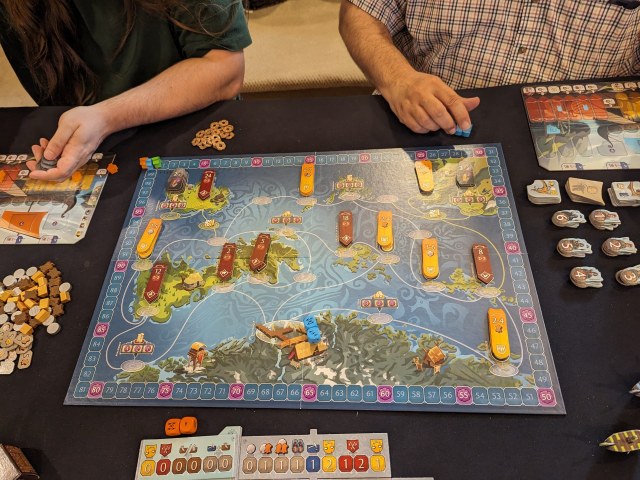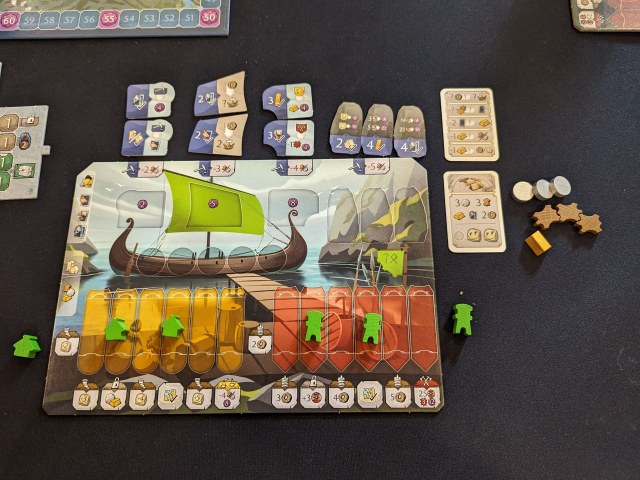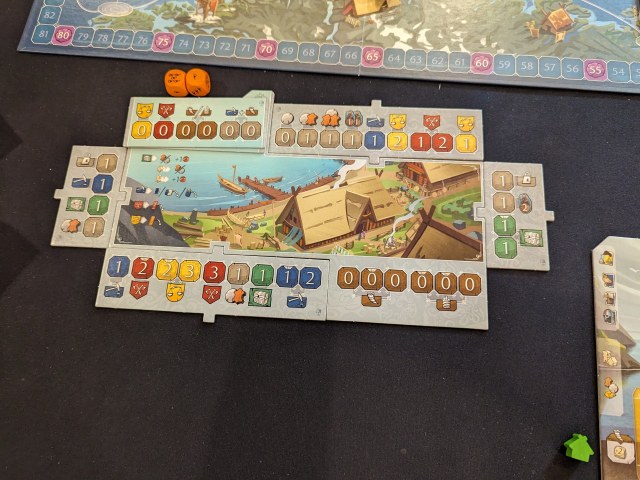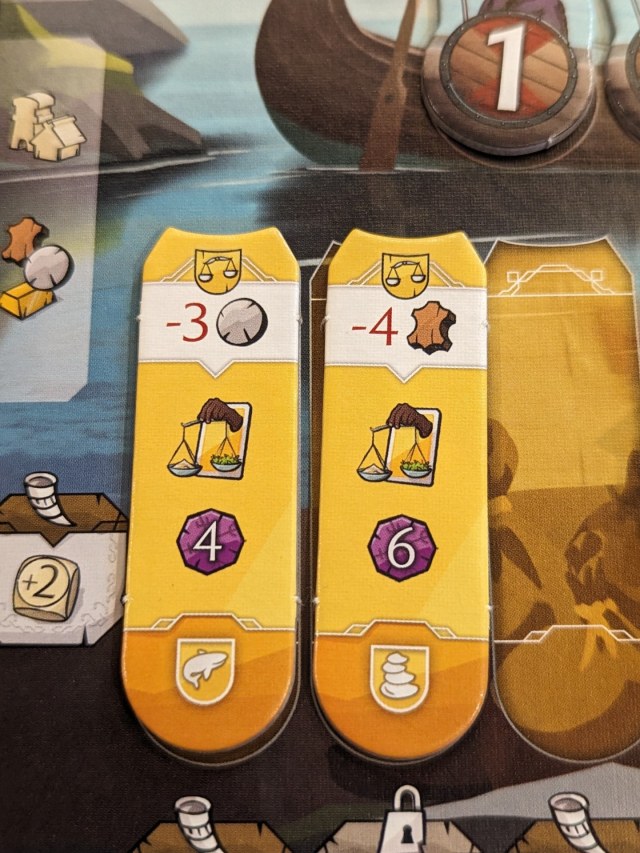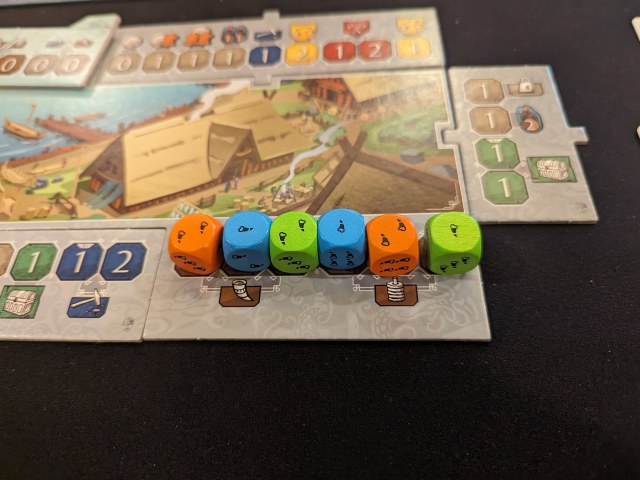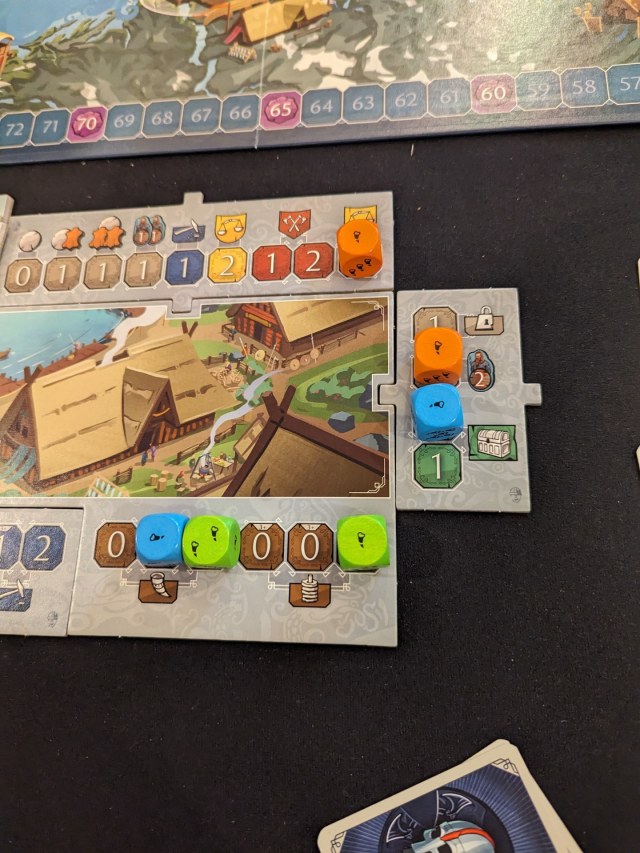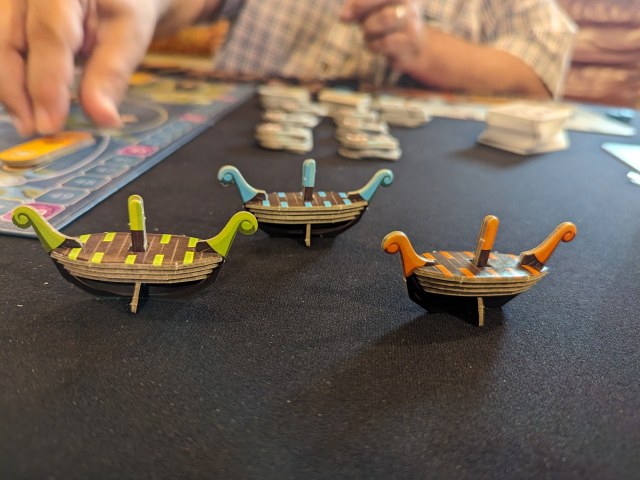Karvi
- Designer: Torgeir Tjong
- Publisher: Hans im Glueck
- Players: 2-4
- Age: 14+
- Time: 120-180 minutes
- Played with review copy provided by Asmodee NA
As a Jarl, you travel the northern seas to achieve immortal glory. Under the sails of your own ship, which is built like a karve (Karvi), you‘ll lead a crew, trade with foreign cultures and plunder other lands. Strengthen the skills of your crew by upgrading your ship and hiring stronger warriors. Whether you wish to establish new trade routes to secure rare goods or battle distant settlements to plunder their riches, your path to glory is yours to choose. But make sure to remember to stock up on beer and bread, so you have enough supplies to outmaneuver the competing clans. Successful planning will make you renowned throughout the lands, and secure your place in Norse legend as a fearless Jarl.
To set up the board – which shows a bunch of islands and ports scattered about the sea – place the raid and trade tiles (1 per player) on the matching spots. The special purple rune stones are split between the two spots in the upper corner. All of the player ships start in the bottom center of the board. The Action Track board is set nearby with the modular board inserts all placed on the appropriate player count side and the round end tiles in the upper left corner. The Trade deck is shuffled and a three card display is made. Finally the three types of upgrade card decks are assembled and placed near the board.
Each player gets their own player board, this is where you will keep your earned Raid and Trade banners as well as upgrade tiles for your ship. You are dealt two of each of the three types of ship upgrades as well as 3 rune stones. Players choose one rune stone to activate for free and place it on their board. Keep the rest of the rune stones and upgrades above your board for now. You also get 3 towers and 3 trading posts. One each starts in your supply, the other two are placed on the corresponding spots on your raid and trade banner tracks. Each player then gets a start card which gives your starting resources and starting turn order. Based on the information on the cards, players will place their dice on the Action Track in snake order.
The number of beers on a die shows the number of action points that the die currently has. Spaces on the action track have a number printed on them; this represents the number of beers that must be subtracted from your die in order to take that action. On a player’s turn, he first must move one of his dice clockwise to an empty action space, pay the cost of the space and then take the associated action. If you have no pips on your die, you can only choose an action with 0 points. Turn order is determined by the dice on the track – the dice which is furthest back gets to take the next turn. It is quite possible that a single player get multiple turns in a row if his dice are continually the furthest back.
But let’s not get ahead of ourselves. Let me backtrack a bit and give an overview of a player turn. On a turn, the big thing that happens is that the active player (the one whose dice is furthest back) moves a die on the track and does an action. The player can also take a number of free actions that can happen at any time in their turn:
- Move your ship – once per turn, spending 1 provision (donut) per space moved. You can only do this once per turn. You cannot end your space on an occupied space; a stronger ship (with more combat strength) will displace a weaker ship to an adjacent space. If you end your movement at a location, you can take a Trade banner or Raid banner (by picking up all available banners at that location, looking at them, and choosing one to keep) or you can build a building assuming you have one available in your supply.
- Play an upgrade card from your hand – ship cards allow you to move your ship or get provisions, beer cards give you beer or special action benefits, helmet cards affect your combat strength
- Discard 2 upgrade cards for a gold
- Exchange Gold for a coin, fur, donut or a beer on a die.
Examples of the main dice action are:
- Gaining resources (take the coins/furs/donuts as shown)
- Add beer to your dice
- Add combat strength – add a warrior to your ship
- Increase combat strength – replace a warrior on your ship with one with higher value
- Draw an upgrade card – choose which deck to draw from
- Play a ship upgrade or Rune stone – you must be able to pay the “cost” for the upgrade
- Treasure chest – gain fur/coins, increase your combat by 1, then take bonuses for each building you have built
- Trade – complete a previously obtained trade tile by discarding the resources on the tile, place the tile on your player board in the Trade track. Choose one of the trade cards and gain the things shown on it. As you pass certain spaces on the track, you can gain increased beer actions or unlock portions of the map.
- Raid – complete a previously obtained raid tile by showing you have combat value equal to that shown on the tile. Take damage as shown (flip a healthy warrior over or discard an already hurt warrior and score points equal to strength). Score VP as shown on the tile then place the tile on your player board on the Raid Track.. As you pass certain spaces on the track, you can gain increased provisions actions or unlock portions of the map.
- Locked action – gain things on the space, but you can only take this action if you have progressed far enough on the Trade or Raid track on your board
There is a little replenishing area about halfway through the Action track with spaces that give you more beer and spaces that give you more provisions; all for 0 cost. While you are not obligated to stop here, it rarely makes sense to bypass them. All of these spaces provide the same benefit, so usually the first person into this area will end up being the first person out. .
At the end of each round, there is another set of 0 cost spaces in the stop area. Dice may not move out of this area until it is full (and the current round ends). Turn order for the next round still is done in the same way – the furthest back die goes first; so you will have to balance the action you get at the end of this round with your desired place in order to start the next round.
The game is played over 3 rounds, and at the end of that third round, there is a bit of final scoring.
- Points for each runestone played to the player board
- 1 point per combat strength of your existing warriors (you have already scored for all discarded warriors along the way)
- Score the square of the number of your trade tiles on your boar
- 1 point per pip left on your dice
- 1 point per 2 provisions
- 1 point per gold/2 upgrade cards
- 1 point per 2 resources (coin/furs)
The player with the most points wins. Ties broken in favor of first in turn order if another turn was to be played.
My thoughts on the game
Karvi is a 2023 SPIEL release, but it was not one of the games that I brought home from the convention. Supplies were limited, and it was pretty unclear at the time whether the EN rules were going to be available (I later learned that HiG had printouts that they were including when you bought it…). Oh, and it is hefty. I was already at a crunch for weight – so hard decisions had to be made. My contacts at Asmodee let me know that they were already planning an EN release, and as a result, this one went on the waiting list. Lo and behold, the EN version is now available and I’m super glad to have a copy now to try out.
I’ll start out by saying that this one is right at the edge of my complexity and length boundaries. Games that promise a 3 hour game are definitely at the upper end of my current attention span limits. That being said, I trust the Hans im Glueck people to deliver a game that is worthy of that time commitment, and that helped me mentally tackle this complex game. The publisher is clearly aware of these issues as the EN version even has a sticker on the shrinkwrap warning you of the complexity.
In the end I really liked this game – it has a very old school feeling to it. In the sense that I could easily have seen 2010-me playing a game just like this and enjoying it the same. The game incorporates a number of tried and true mechanisms that are woven together into a tight framework.
The action board rondel provides you with many interesting decisions, and unlike a lot of rondels, you not only have to consider position on the track but also the cost of the action that you are going to take. In general, the action point (beer) situation is tight. Until you improve your beer making engine (through raid tiles), you’ll only gain 2 points each time you take a make beer action – so every point is precious. The actions on the track are cleverly spaced, sometimes tempting you to make a much larger jump forward to get a lower cost action (with the identical action at a higher cost in a closer spot).
Other than actions on the rondel, there are plenty of things to race for on the board as well. The first player to each Trade or Raid site gets a big advantage as they get first pick of all the available tiles there. The first player to each of the building spaces will get the highest valued space. The first player to unlock the upper corners of the map will get first chance at those sites locked behind.
Each turn, you’ll be working through a multi layered puzzle trying to take the action you want at the lowest possible cost; making sure at each step that you have the required resources/donuts/etc to do the things you want to do. It’s a tough challenge at times, and certainly some of the longer game play is due to certain turns taking a few minutes to be worked out through mental gymnastics..
So, I’ve only played a few times, but the one thing that comes up is the weird luck-of-the-draw aspects to the ship upgrades and the runestones. I would definitely say that they are not equal, and you get a random draw of 2 of each ship upgrade and 3 runestones. This is the only supply that you will get to choose from for the entire game, and no other player will have access to the ones that you were dealt. It certainly seems possible that a player is dealt a lesser selection than another player, and there isn’t anything to be done about it. There is a drafting variant to lessen this effect, and I probably would not play the game without it going forward. Though, admittedly, for a first game, there probably isn’t an issue with random draw because a newbie would really have no way to process which tiles might be stronger than others.
That little quirk aside, I pretty much like everything else about Karvi. If I’m going to play a game in the 2+ hour range, I want it to feel like this one does – with important decisions to be made each turn. Again, the rondel coupled with the relative tightness of resources and action points makes each turn a deliciously difficult decision.
Thoughts from other Opinionated Gamers
Dan B. (1 play):I like a lot of what this does but it really seemed as if the ship upgrade tiles were not well balanced – in particular the tile that lets you move anywhere for a fixed cost seemed extremely strong. I guess the drafting variant would help with this but I am not convinced it would solve it. That being said, I’d be willing to play again, although with no more than three players as even with three it went longer than I felt it needed to.
Ratings from the Opinionated Gamers
- I love it! Dale Y, John P
- I like it.Joe H., Dan B. (borderline)
- Neutral.
- Not for me…


